What is the best time to visit the Kedarkantha Trek? If you’re a trekker or someone curious about the trekking experience, this is one of the most controversial questions you may have encountered. Kedarkantha Trek, also known as the “Queen of Winter Treks,” is undoubtedly one of the best winter treks in India. But the real question is, Is Kedarkantha Trek just a winter trek?
The answer might surprise you, but it’s NO. The Kedarkantha Trek can be enjoyed at any time of the year except during the monsoon season. Spring and summer offer ideal weather for trekking, while winter presents a more challenging experience for those seeking adventure. It’s a year-round trek capable of satisfying a variety of trekking needs—that’s Kedarkantha Trek in a nutshell.
Before diving deep into analyzing the best time or season to visit Kedarkantha, let’s take a quick look at its basic details:
- State: Uttarakhand
- Altitude: 12500Ft.
- Base Camp: Sankri
- Duration: 5 Days
- Trek Difficulty: Easy To Moderate
- Trek Length: 20km
- Start and End Location: The starting and ending point of the trek is Sankri.
- Base Camp: The base camp for the trek is also in Sankri.
- Closest Train Station: The nearest train station is in Dehradun.
- Closest Airport: The nearest airport is Jolly Grant Airport in Dehradun.
- Last ATM: The last ATM is located in Purola near Sankri.
- Trek Route: The route for the trek is Sankri – Juda ka Talab – Kedarkantha Base camp – Kedarkantha peak.
The Kedarkantha Trek, located in the Garhwal Himalayas of Uttarakhand, is a stunning hiking trail situated in the Govind Wildlife Sanctuary in the Uttarkashi district. This trek typically takes around 4 to 5 days to complete, covering a distance of approximately 20 km and reaching an elevation of roughly 12,500 ft. The trail offers moderate challenges, making it suitable for trekkers of all levels of experience. This trek provides an opportunity for trekkers to visit a spiritual site believed to be the meditation spot of Lord Shiva, hence the peak being named “Shiva Ka Kanth” (Kedar’s Kanth), with “Kanth” referring to “Throat”. At the summit of the Kedarkantha peak, trekkers can find a small makeshift temple dedicated to Lord Shiva.
The Best Time to Visit Kedarkantha Trek
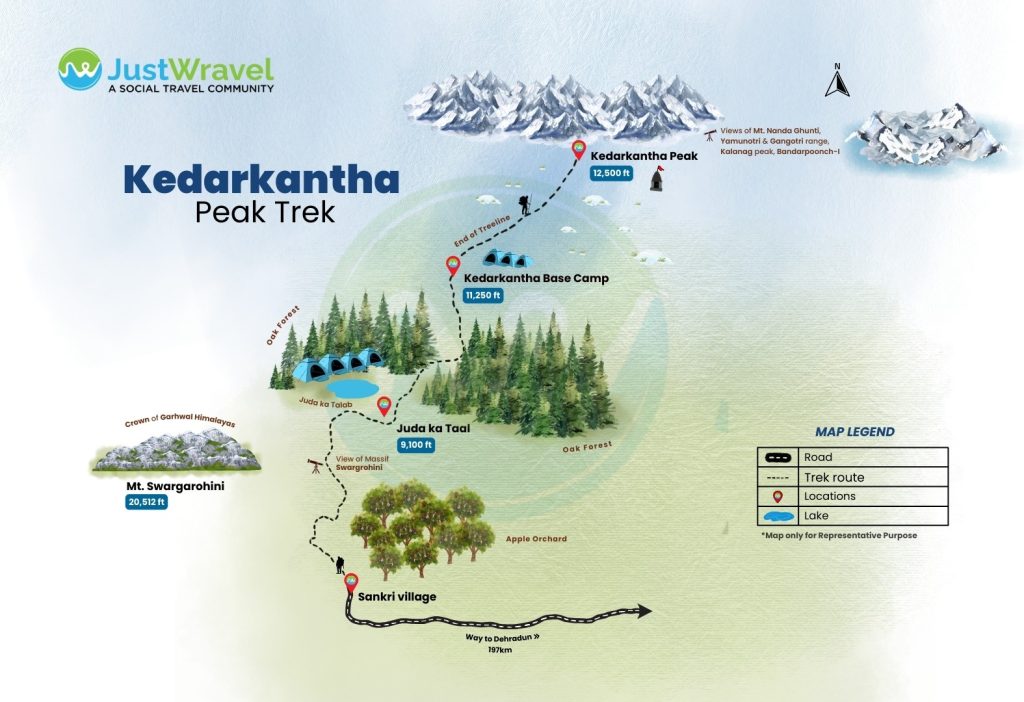
The Kedarkantha trek, nestled in the picturesque Himalayas of Uttarakhand, is a captivating destination that attracts trekkers year-round. Each season offers a unique experience, making it essential to choose the best time to visit the kedarkantha trek based on personal preferences. From the enchanting snow-covered landscapes in winter to the vibrant blooms of spring and the lush greenery of summer, every season showcases the trek’s natural beauty. While winter (December to March) is renowned for its pristine snow, spring (March to April) and autumn (October to November) provide pleasant weather and stunning views, making them ideal for trekking enthusiasts.
| Season | Months | Temperature |
| Winter | December to February | Day: 8°C to 10°C, Night: -10°C or lower |
| Spring | March to April | Day: 10°C to 15°C, Night: 0°C to 5°C |
| Summer | May to June | Day: 15°C to 20°C, Night: 6°C to 10°C |
| Monsoon | July to September | Day: 10°C to 15°C, Night: 0°C to 5°C |
| Autumn | October to November | Day: 10°C to 15°C, Night: 0°C to -5°C |
Plan your Kedarkantha Adventure HERE…
Winter Season ( November to March)

Winter is one of the best time to visit Kedarkantha Trek. The Kedarkantha Trek is renowned for its winter treks, making it exceptionally stunning and offering picturesque views during this season. December is ideal for visiting the Kedarkantha Peak as the landscape is blanketed in snow. However, despite the enchanting scenery, winter also brings various challenges that trekkers should be wary of. The months of December to February offer a picturesque sight with snowfall, making the weather and scenery absolutely stunning. January experiences the highest amount of snowfall in Kedarkantha, transforming the pine trees into a breathtaking spectacle. The peak winter months of December, January, and February bring extremely cold nights, so it is essential to pack accordingly for the weather. With the harsh cold conditions, it is advisable to layer your clothing with at least 3 layers, which also means your backpack will be heavier during the winter season. During the trek, there is a possibility of encountering blocked paths caused by heavy snowfall. Therefore, it is important to proceed with caution and have extra time in case of such obstacles. The winter landscape of Kedarkanth is enchanting, covered in a beautiful layer of snow that enhances the trekking experience.
- Temperature:
- Daytime: 8°C to 10°C
- Nighttime: -10°C or lower
- Highlights: A winter wonderland with snow-covered trails; popular for snow trekking and skiing.
- Suitable for: Adventurous trekkers looking for a challenge; requires good physical fitness.
- Clothing: Multiple layers including thermal base layers, insulated jackets, gloves, and hats; snow gear is crucial.
- Difficulty: Challenging. Snow-covered paths and frigid temperatures require careful navigation and physical stamina.
Read More: Kedarkantha Trek Guide
Spring Season ( March-May)
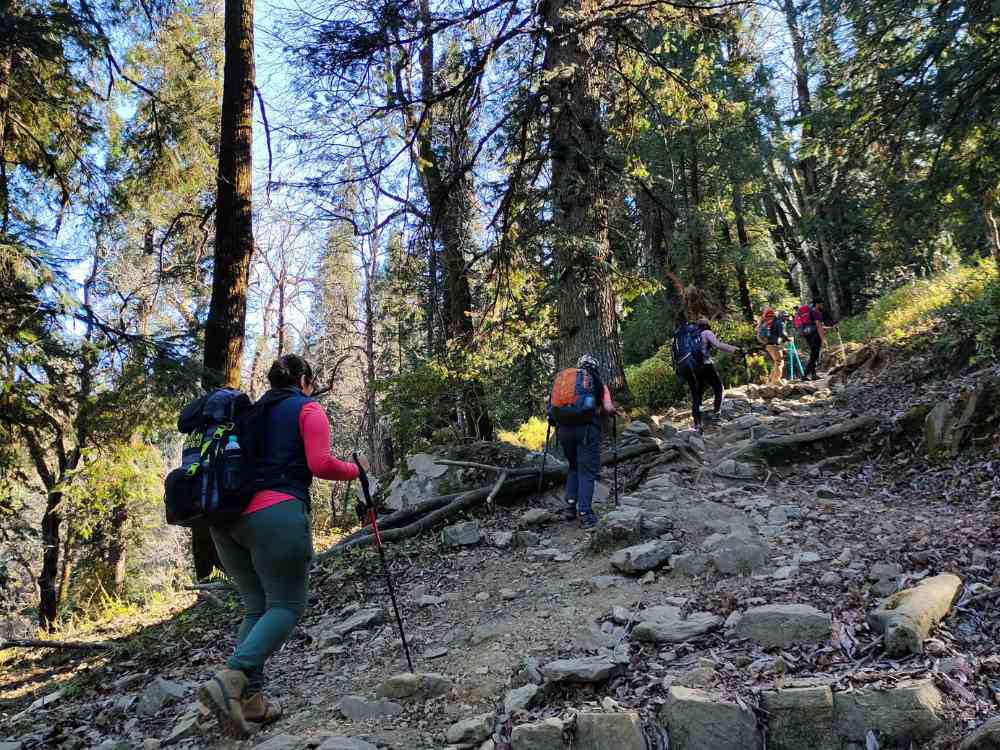
The period between March and April is known as the spring season. Even though March is technically considered spring, Kedarkantha still has snow during this time. The higher the elevation of the peak, the more snow you will find. While the daytime temperatures are warm, the nights can be quite cold. As April arrives, the snow begins to melt due to higher temperatures than in March. At lower elevations, you will be greeted by a beautiful display of colorful flowers, which is a delightful sight. The spring season also brings the blooming of Rhododendrons, locally known as Buransh. After the cold winter period comes to an end, the arrival of spring adds vibrancy to the surroundings. As April approaches, the landscape transforms with an array of diverse colors. This time of year provides the perfect conditions for embarking on the Kedatkantha trek. All these factors make Spring the best time to visit Kedarkantha Trek.
- Temperature:
- Daytime: 15°C to 16°C
- Nighttime: 0°C to 5°C
- Highlights: Combination of melting snow and blooming flora; ideal for witnessing both winter and spring beauty.
- Suitable for: All trekkers; particularly enjoyable for those wanting moderate temperatures with some snow remaining.
- Clothing: Layered clothing with a warm jacket; comfortable trekking shoes are essential.
- Difficulty: Easy to Moderate. The trails are becoming more accessible as the snow melts but still require some caution on steeper sections.
Suggested Read: The Best Kedarkantha Trek Itinerary
Summer Season (May-June)

In May, the sun’s warmth makes the mornings hot, while the nights are twice as cold. As a result, there is little snow left in the valley as it has melted away. June brings rain showers, earning it the title of the beginning of the monsoon season During the summer, many individuals choose to embark on high-altitude treks, leading to fewer crowds and making it more convenient for you to complete the Kedarkanatha trek. The rainy season brings about pleasant weather and the chance to experience the fragrance of the meadows. For the nature lovers and those who get excited with green meadows, Summer is the best time to visit Kedarkantha Trek.
- Temperature:
- Daytime: 15°C to 20°C
- Nighttime: 6°C to 10°C
- Highlights: Lush green landscapes with blooming wildflowers; ideal for family treks.
- Suitable for: Beginners and families; pleasant weather makes it accessible.
- Clothing: Light layers, breathable fabrics, and a light jacket for cooler nights.
- Difficulty: Easy. The terrain is generally manageable with gradual ascents and well-marked paths.
Extended Read: How to Reach Kedarkantha Trek
Monsoon Season (June – August)
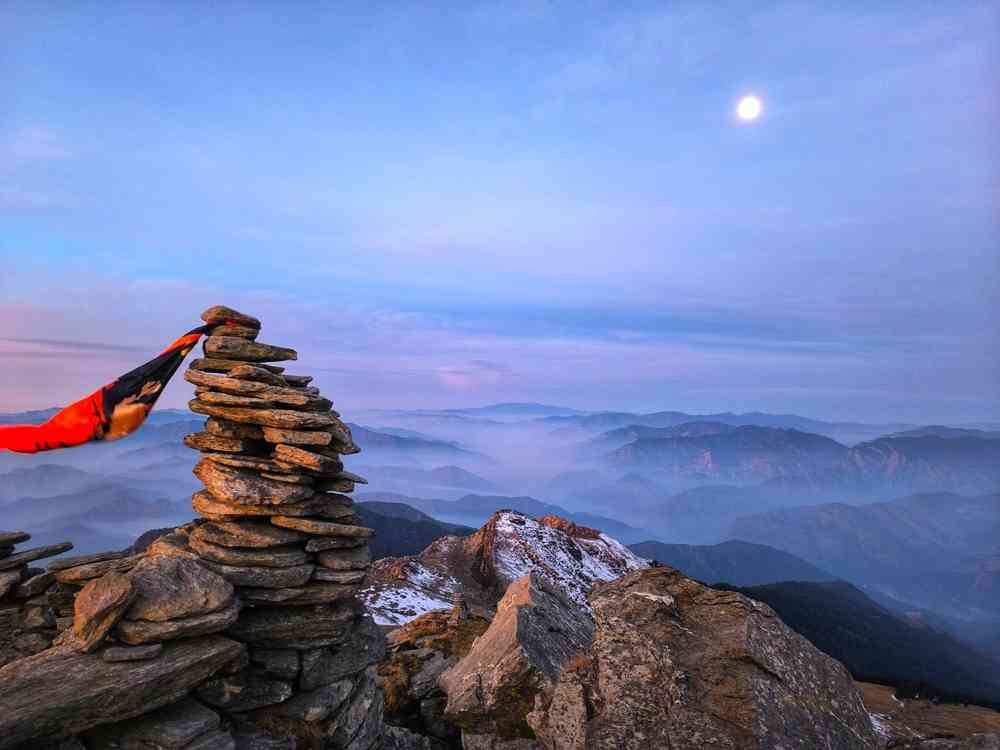
During the Monsoon season from June to August, completing the Kedarkantha trek may be challenging due to the rain. August is typically known for heavy rainfall, resulting in slippery trails. August offers picturesque green landscapes along the trail. High altitudes may experience foggy conditions due to the rain, potentially reducing visibility and causing confusion during the trek. It is important to proceed with caution in such conditions. The distinctive weather in August brought on by the rain creates a one-of-a-kind atmosphere, attracting hikers who seek adventure in the unique environment. Despite the challenges faced during this time of year, the beauty of nature never fails to amaze us with its tranquil offerings.
- Temperature:
- Daytime: 10°C to 15°C
- Nighttime: 0°C to 5°C
- Highlights: Dramatic scenery with waterfalls; challenging trekking conditions due to slippery trails.
- Suitable for: Experienced trekkers looking for adventure; not recommended for beginners.
- Clothing: Waterproof gear, warm layers, and sturdy trekking shoes; extra sets of clothes are advisable.
- Difficulty: Moderate to Challenging. The risk of landslides and slippery paths increases the difficulty level significantly.
Autumn Season (August -October )
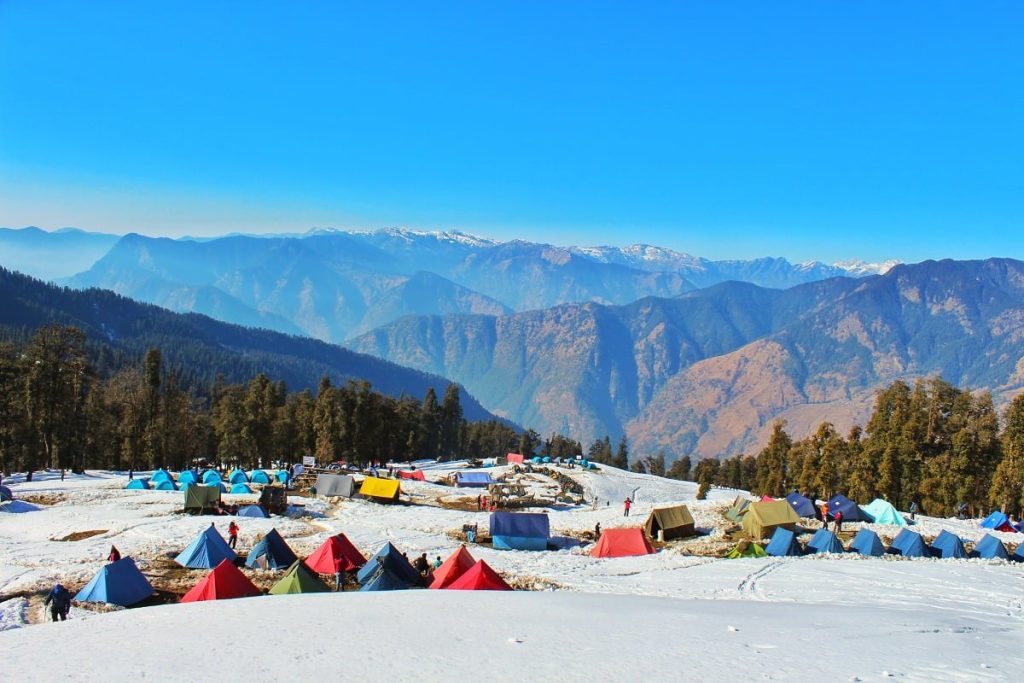
The period from September to October marks the arrival of Autumn in Kedarkantha Trek, with temperatures ranging from 0 to 15 degrees Celsius. During this season, the weather is typically clear, and the breezes feel refreshing without being overly chilly. As November progresses, the lush green meadows gradually transition to shades of brown, and eventually, the leaves and grass dry up and fall to the ground. The mountains have a lush green color, signaling the beginning of the colder months with the arrival of autumn.
- Temperature:
- Daytime: 10°C to 15°C
- Nighttime: 0°C to -5°C
- Highlights: Clear skies and vibrant fall colors; great visibility of the Himalayas.
- Suitable for: Photographers and nature lovers; pleasant trekking conditions.
- Clothing: Warm layers including thermal wear; a good quality jacket is essential.
- Difficulty: Moderate. The trails are generally stable but may involve some steep sections.
Best Season for Kedarkantha Trek
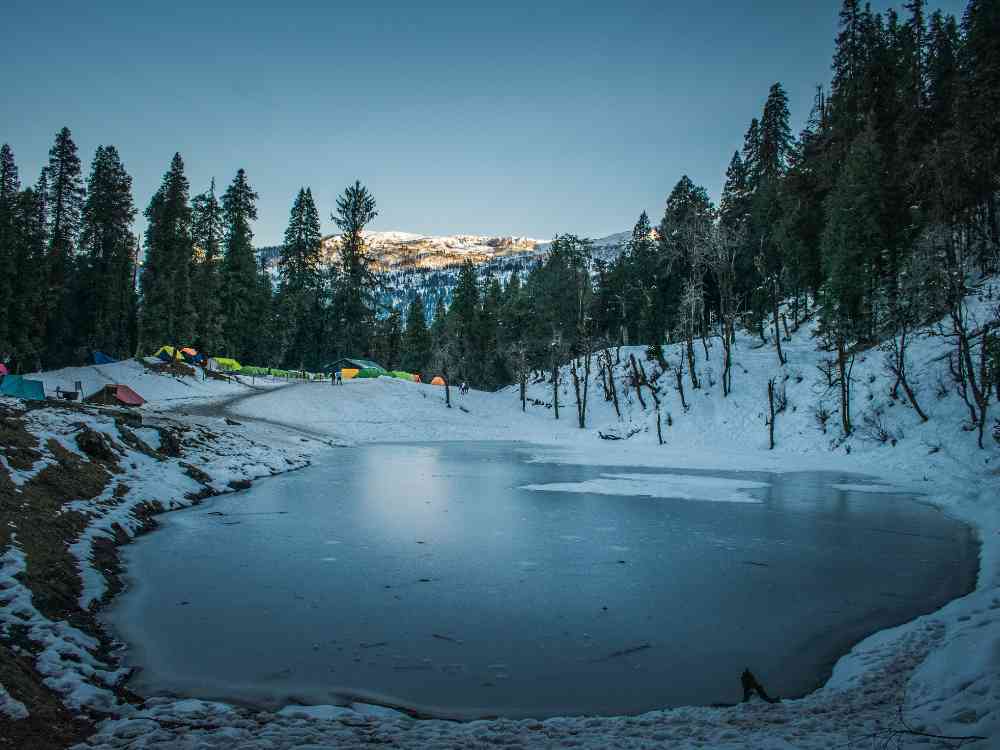
Winter Season ( November to March)
November brings in the cold at Kedarkantha, and as December approaches, the temperatures drop even further. The winter at Kedarkantha can be brutal, with the mercury dipping below zero after dark. In December, temperatures at Kedarkantha can plummet to anywhere between 0 and minus 10 degrees Celsius once the sun sets. Snow and frost are regular features, and you will often find yourself trudging through fresh snow and slush. During the day, the temperature stays between 8-10 degrees Celsius, but at night it consistently drops below zero. Occasionally, it can be quite windy. It is advisable to have appropriate winter attire and suitable trekking equipment to protect against the cold and snow. The following are some of the highlights of the Winter season:
- During the winter season, Mother Nature blankets the world with shimmering snow, revealing an enchanting side to life. The entire region is cloaked in a layer of snow, from the forests to the meadows and mountains, creating a breathtaking winter wonderland.
- The snowy trails can present some challenges, particularly in terms of slippery conditions that may lead to slipping. It is important to prioritize physical health and safety while navigating the snowy terrain.
- Juda ka Talab, a renowned lake in Kedarkantha, completely freezes over in winter, transforming the campsite into a pristine white landscape.
- The cold temperatures of December make it the chilliest month for Kedarkantha trekking, with frigid nights adding to the frosty atmosphere.
- Despite the various challenges, the month of December offers trekkers breathtaking views that can make them forget about the worries of the outside world.
Weather and Temperature of Kedarkantha Trek
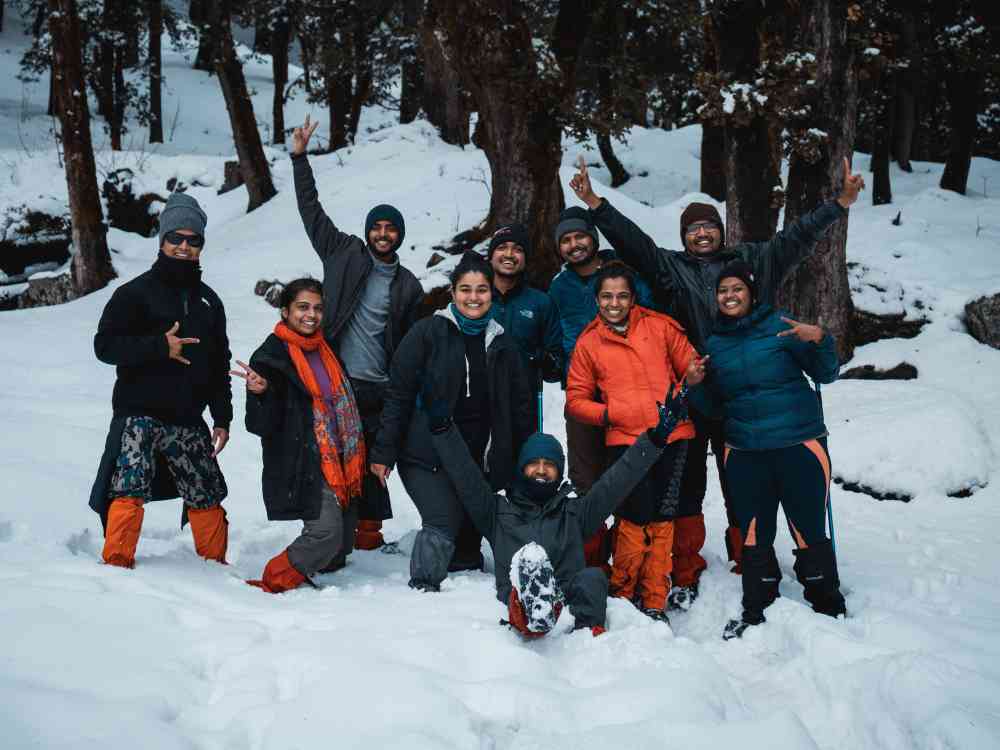
Understanding the monthly temperature variations is crucial for planning your trek to Kedarkantha. Nestled in the stunning Himalayas, this trek offers diverse experiences throughout the year, influenced by seasonal changes. From the snowy landscapes of winter to the vibrant blooms of spring and the lush greenery of summer, each month presents unique weather conditions. This temperature chart provides a detailed overview of day and night temperatures, along with general weather patterns, helping trekkers choose the best time to visit Kedarkantha Trek.
| Season | Month | Day Temperature | Night Temperature | Weather |
| Winter | December | 8 to 10 | -10 to -5 | Cold, snowy |
| Winter | January | 6 to 8 | -10 to -5 | Very cold, heavy snowfall |
| Winter | February | 8 to 10 | -5 to 0 | Cold, possible snowfall |
| Spring | March | 10 to 15 | 0 to 5 | Pleasant, snow-melting |
| Spring | April | 15 to 16 | 0 to 5 | Mild, blooming flowers |
| Summer | May | 15 to 20 | 6 to 10 | Warm, lush greenery |
| Summer | June | 15 to 20 | 6 to 10 | Warm, pleasant |
| Monsoon | July | 10 to 15 | 0 to 5 | Rainy, slippery trails |
| Monsoon | August | 10 to 15 | 0 to 5 | Rainy, humid |
| Autumn | September | 10 to 15 | -2 to 0 | Clear skies, cool |
| Autumn | October | 10 to 15 | -2 to 0 | Crisp weather, clear visibility |
| Autumn | November | 10 to 15 | -2 to -5 | Cold nights, clear days |
Choosing the Right Season for the Kedarkantha Trek
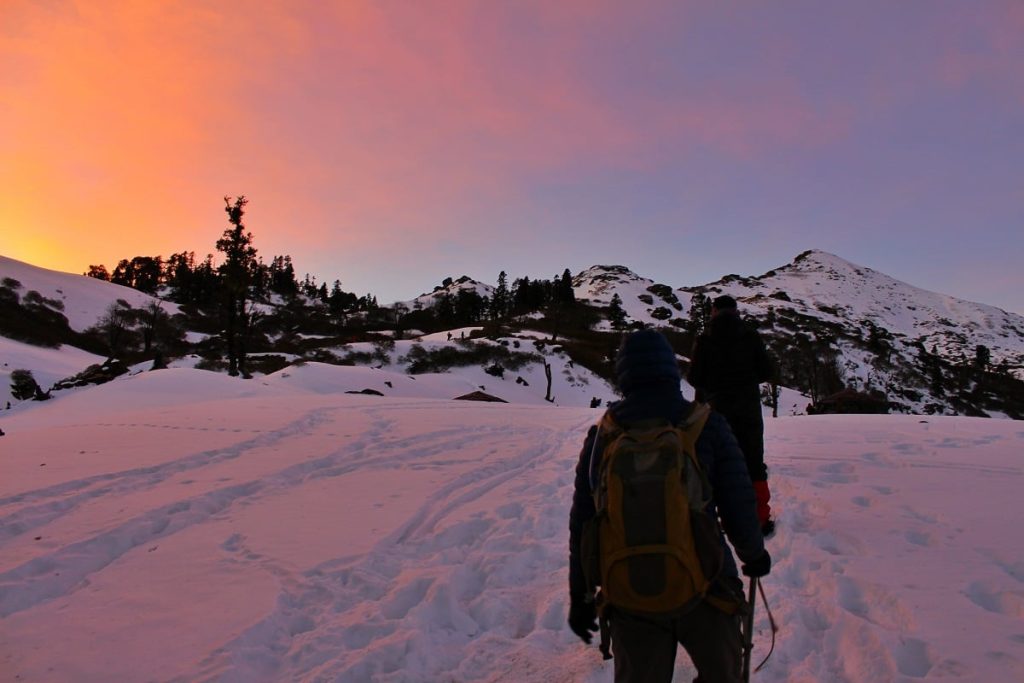
Selecting the ideal season for the Kedarkantha trek is essential for maximizing your experience in this breathtaking Himalayan region. Each season offers distinct weather patterns, landscapes, and trekking conditions, making it crucial to align your choice with your preferences and abilities. Whether you seek the serene beauty of snow-covered trails in winter, the vibrant blooms of spring, or the lush greenery of summer, understanding the nuances of each season will help you prepare effectively.
- Weather Conditions: Each season brings different weather patterns. Winter (December to March) offers snow-covered landscapes but also frigid temperatures, while spring (March to April) and autumn (October to November) provide milder weather and blooming flora.
- Trek Difficulty: The trek is classified as easy to moderate, but winter conditions can make it more challenging due to snow and ice. Consider your fitness level and experience when selecting a season.
- Crowd Levels: Popular trekking seasons like winter and spring may attract more trekkers. If you prefer solitude, consider visiting during the shoulder seasons.
- Gear Requirements: Different seasons require varying gear. Winter necessitates specialized equipment like microspikes and warm clothing, while summer gear can be lighter.
- Altitude Acclimatization: The trek reaches altitudes of 12,500 feet. Ensure you are prepared for altitude sickness, especially in winter when rapid ascent can be more pronounced.
- Personal Preferences: Consider what you want from the trek—whether it’s snowy vistas, lush greenery, or clear skies—and choose a season that aligns with your expectations.
FAQs
What is the difficulty level of the Kedarkantha trek?
The Kedarkantha trek is classified as easy to moderate, making it suitable for both beginners and experienced trekkers. It involves a gradual ascent with some challenging sections, especially during winter when snow can complicate the trail.
How long is the Kedarkantha trek?
The total distance of the trek is approximately 20-24 kilometers, typically completed over six days. Each day, trekkers cover about 5 kilometers on average.
What is the best time to do the Kedarkantha trek?
The best time to visit Kedarkantha is from December to April, particularly for those who enjoy snow. However, spring (March to April) and autumn (October to November) also offer pleasant trekking conditions.
Is Kedarkantha suitable for beginners?
Yes, the Kedarkantha trek is considered beginner-friendly due to its moderate difficulty level and well-marked trails. However, basic physical fitness is recommended.
What should I pack for the Kedarkantha trek?
Essential items include warm clothing, trekking shoes, a good quality backpack, a sleeping bag, trekking poles, and personal items like sunscreen and a first-aid kit. Specific gear may be needed depending on the season.
How high does the Kedarkantha trek go?
The summit of Kedarkantha reaches an altitude of 12,500 feet (3,810 meters), starting from around 6,455 feet at Sankri village.
Are there any safety concerns on the Kedarkantha trek?
While generally safe, trekkers should be cautious of altitude sickness and changing weather conditions. It’s advisable to trek with a guide or in a group for added safety and support.
Choose the best time you want to visit Kedarkantha Trek and witness the majestic beauty!!!







